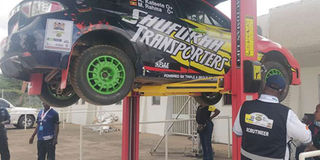Kenyan road security tested in WRC dress rehearsal

The Subaru Impreza of Ugandans Abdul Kateete and Rehma Mohamed goes through pre-competition scrutineering tests on July 4, 2019, at the pre-competition area of the Safari Rally at Kasarani. PHOTO | ANWAR SIDI |
What you need to know:
- The WRC series has undergone numerous changes to its championships and modification rally cars compared to those that competed in the 1980s and 1990's.
- The current breed of rally cars have become more compact and faster than their predecessors.
- Gone are the days of the Kenyan Safari rally when the difference between victory and defeat sometimes depended on which car avoided herds of cattle wandering on the roads.
NAIROBI
Kenya's road safety standards will come under scrutiny when the Safari Rally, a dress rehearsal for the proposed return of the world rally championship in Africa since 2002 gets underway on Friday.
Over 50 competitors from seven countries, and a group of observers from three World Rally Championships (WRC) works teams, including Toyota and Ford will be in Nairobi for the three-day event which starts outside the Kasarani sports stadium.
Kenya is taking no chances on the safety of both rally cars and spectators in the 881km long rally, with all attention focused on the country's preparedness for a return to the WRC championship in 2020.
"I believe the country has met all the FIA regulations in regards to safety and organization, and we are ready to hold a world class event," said Phineas Kimathi, who chairs a government-sponsored committee to organise the event.
The Kenyan government has spent close to 205 million shillings ($2 million) to bid, prepare and organize the candidate event, as a prelude to a three-year commitment to hold a WRC race in the country, and is sparing nothing to have a successful event.
The FIA and WRC promoter will be fully engaged in organising and observing the rally, and they are expected to make the final decision whether or not Kenya will be suitable to return to the WRC calendar next year after the competition.
This year's rally, which also counts to the African Rally championships, will run on closed roads and private farms proposed for next year's WRC rally.
Most of the routes will be closed to Kenyan spectators, but they will catch a glimpse of the competing cars at speed around the opening 4.50km super special stage outside the Kasarani stadium, immediately after the ceremonial start of the rally by Kenyan President Uhuru Kenyatta.
Most of the action will be centred around Naivasha and the expansive Kedong Valley in Kenya's Rift Valley, for the most competitive sections of the rally.
On Saturday the cars will tackle two loops of the 132km super fast gravel stages around the Soysambu conservancy in Gilgil, before shifting to the final 220km section around Malewa, Loldia and Kedong on Sunday.
The Safari rally was started as an east African competition between Kenya, Uganda and Tanzania to celebrate the coronation of Britain's Queen Elizabeth II in 1953.
Considered one of the world's toughest rallies, covering over 5,000km across rugged east African savannah, the competition attracted top overseas drivers.
The past winners included Britain's Colin McRae, Spaniard Carlos Sainz, Juha Kankkunen and Ari Vatanen of Finland.
It was diminished in the late 1970s when it became a Kenyan-only affair, and in 2003 it was dropped off the world circuit due to concerns over safety, organization and finances.
The loss of the rally was an embarrassment to Kenya and it has been sorely missed by spectators, who enjoyed the roar of the engines through their neighbourhoods and villages, and would often get their hands dirty helping to push cars out of mud.
The WRC series has undergone numerous changes to its championships and modification rally cars compared to those that competed in the 1980s and 1990's.
The current breed of rally cars have become more compact and faster than their predecessors.
Gone are the days of the Kenyan Safari rally when the difference between victory and defeat sometimes depended on which car avoided herds of cattle wandering on the roads.





